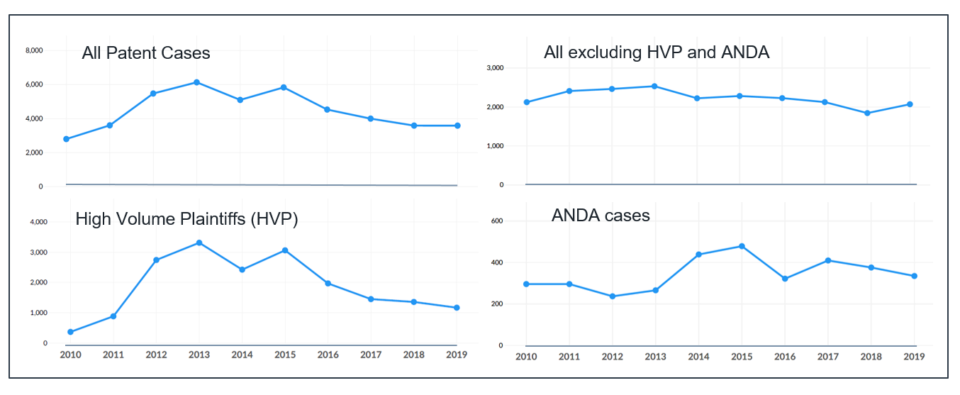Looking back at the past decade, in 2013, filings of patent lawsuits in the United States were at an unprecedented high, and remained that way for a few years to follow. However, the number of patent filing cases has steadily declined in the last few years due to a series of changes in patent law including a higher bar for patenting abstract ideas, restrictions on where patent suits can be filed, and requirements for more detailed allegations of infringement. The lawsuit filing decline appears to have ended in 2019 (just in time for COVID-19), but over the past few months, the trend line shows filing growth once again. If the past is any indication of the future, patent filing lawsuits may actually continue to increase as the pandemic, and its backlash on the global economy, persist.
The increase of patent filing cases as seen in the early 2010s followed on the heels of the 2008 economic recession. As of 2009, filings by so-called “high volume plaintiffs,” typically non-practicing entities in business to monetize their patents, had remained constant for almost a decade at about 300 cases per year. That number increased to almost 400 in 2010, more than doubled to almost 900 cases in 2011, and then tripled to over 2,000 cases in 2012—a manner of increase similar to the spread of the SARS-CoV-2 virus responsible for the COVID-19 pandemic.
The exception to this rise in cases filed were applications for the US generic drug approvals for existing licensed medications or approved drugs – ANDA cases. While ANDA (Abbreviated New Drug Application) cases constitute only a tenth of all patent cases, they are often very high-value cases due to the high profitability of the drug products involved. Thus, even though ANDA cases are not as common as other types of patent filings, the difference in their filing trend is notable.

Let’s take a closer look at the monthly averages for non-ANDA and ANDA cases. As you can see, there are seasonal variations in filings of non-ANDA patent cases, with lows in December followed by increases in the spring.


This data reveals a pattern reminiscent of that seen after the 2008 recession: A decline in filings of ANDA cases and an increase in filings of other types of patent cases. The decline in ANDA filings was consistent throughout 2019 and has continued in 2020, with filings for February, March, and April of 2020 substantially lower than similar months in any of the last three years. In contrast, filings of other types of patent cases appear to be steadily rising. Non-ANDA filings for April 2020 are higher than filings for similar months in any of the last 3 years. Moreover, the increase in non-ANDA filings from February to April in 2020 exceeds any increase for this period of the last 3 years. – This data indicates that filings of patent cases (other than ANDA cases) are on the rise and are rising more rapidly than in past years to higher levels than in past years.
The increase in filings of patent lawsuits coincides with the spread of COVID-19 across the US and the resulting steep slow-down of the economy. The timing may be merely coincidental, but the pandemic may be a causal factor. For example, patent owners who had planned to file cases later in the year may have decided to accelerate the timetable in light of the impending lock-down of businesses, perhaps resulting in a tactical advantage. In addition, patent owners interested in monetizing their assets may view the timing opportunistically, for example, their past damages claim to be stronger now than in the foreseeable future. Patent owners interested in competitive relief (injunction or settlement) may also see an opportunity, as the costs of litigation added to the burdens of the recession may force competitors to abandon products or services.
While the reasons are speculative, the data is compelling. They indicate a rise in filings of non-ANDA patent infringement cases and suggest that patent filings reached a bottom in 2019. Given the similarity of these trends to those seen after the Great Recession, the recent increases could be a harbinger of another boom in patent litigation.




